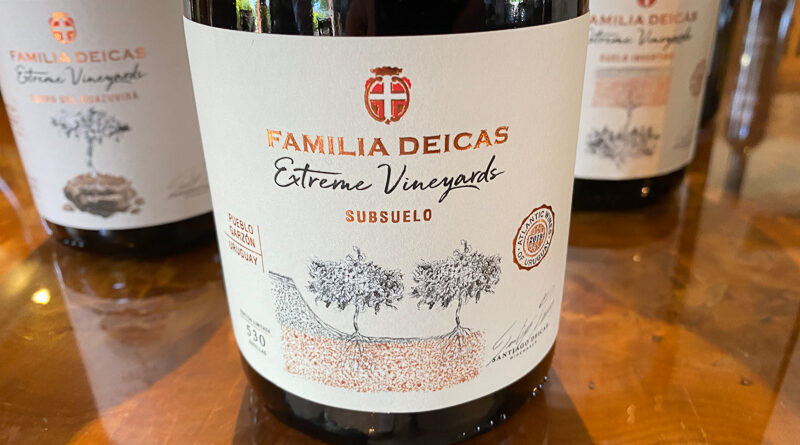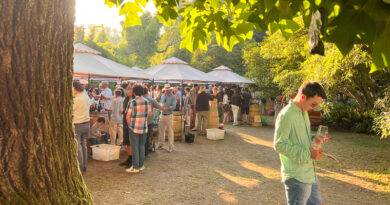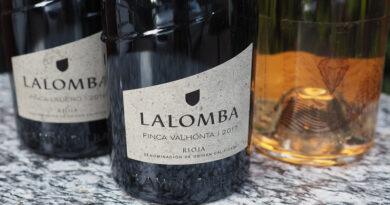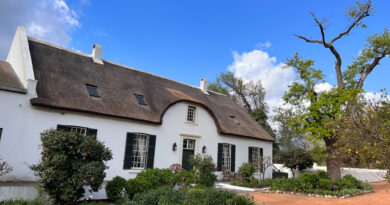In Uruguay: Juanicó Familia Deicas
Website: https://familiadeicas.com/
Juanicó Familia Deicas is Uruguay’s biggest wine company. Originally simply Juanicó, they were once state owned, but were bought by the Deicas family in 1979. They have 300 hectares of vines, including 150 hectares in Juanicó.

The winery in its current form was started by banker Juan Carlos Deicas in 1979, and is currently run by his son Fernando Deicas. The third generation is now involved: Fernando has been joined by his son and winemaker Santiago Deicas, who hosted me on this visit along with viticulturist Gustavo Blumetto.
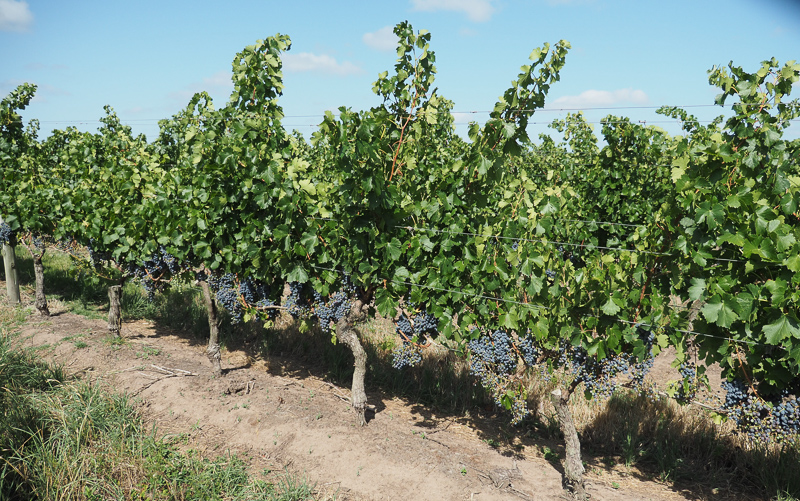
Deicas have a number of brands and make around 3 million bottles annually, exporting a fifth. The top wines are bottled under the Familia Diecas brand which is based on 60 hectares of estate vineyards.
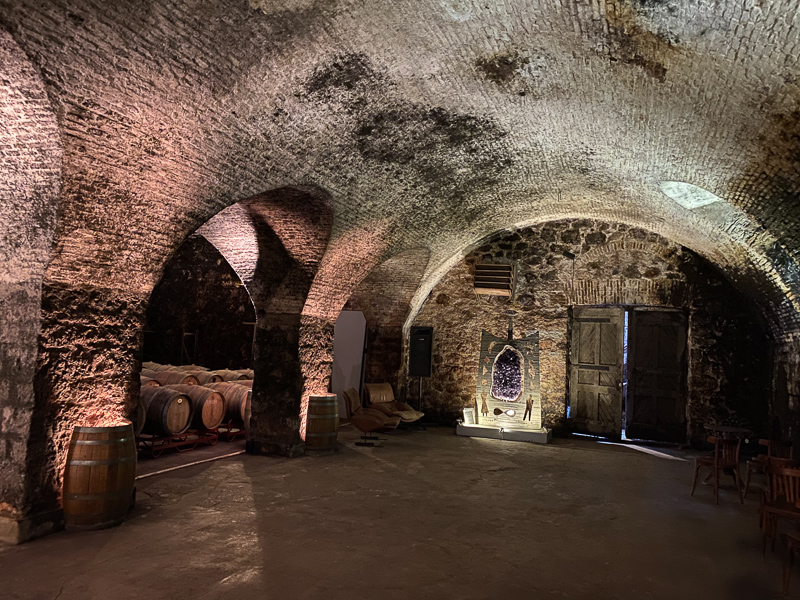
We spent a lot of time looking at vineyards. This has been a focus for innovation for Deicas, and we saw some interesting things.
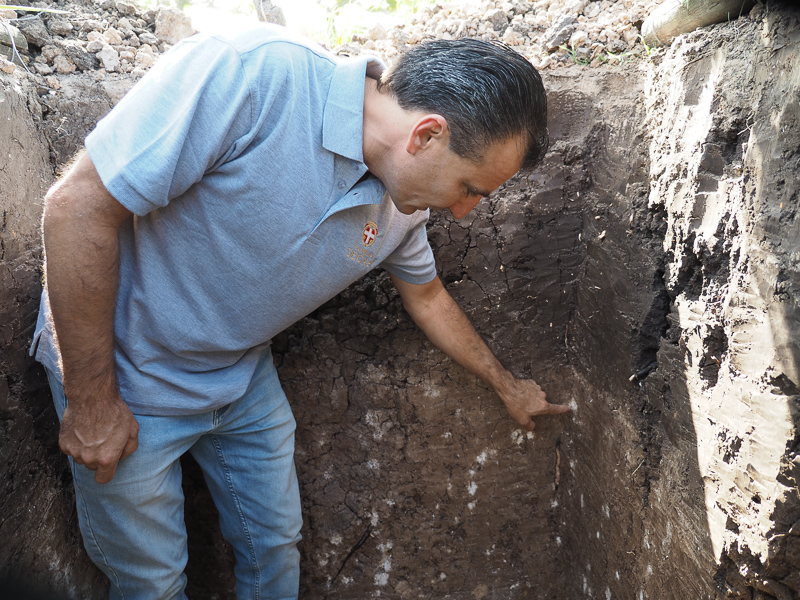
One of the most remarkable – and slightly crazy – projects that I’ve seen in a vineyard is Deicas’ inversion of the soil. In their home vineyard they took a block and removed the two top layers of soil – the heavy clay and then the limestone and clay – and put them back in the opposite order, with the limestone and clay at the top. This block now makes the Extreme Vineyards Suelo Invertido Tannat. The vineyard, with its disturbed soil, was planted straight away. Unsurprisingly, it took 10 years for the vines to get properly established. Generally speaking, soils don’t take well to being moved around, and it takes a lot of time for them to build up again with the correct microbial life. But this was an interesting idea, and the resulting wine is really good.
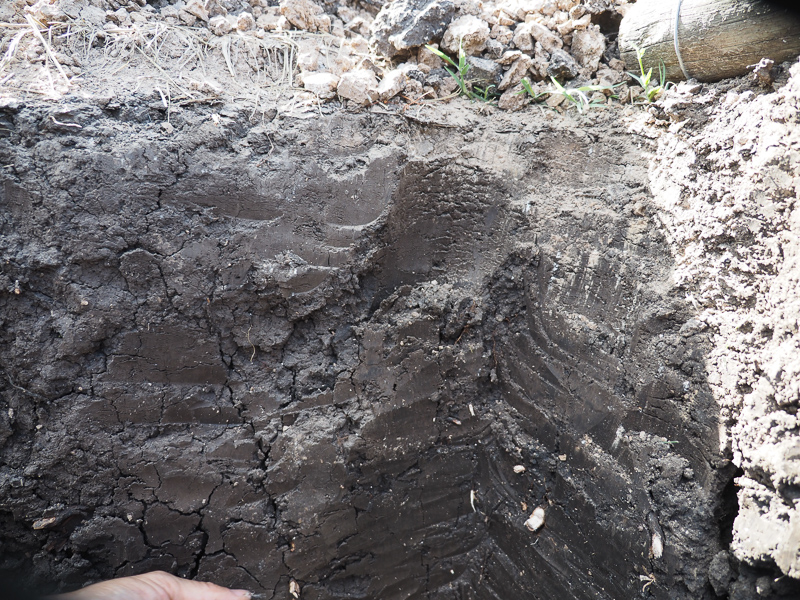
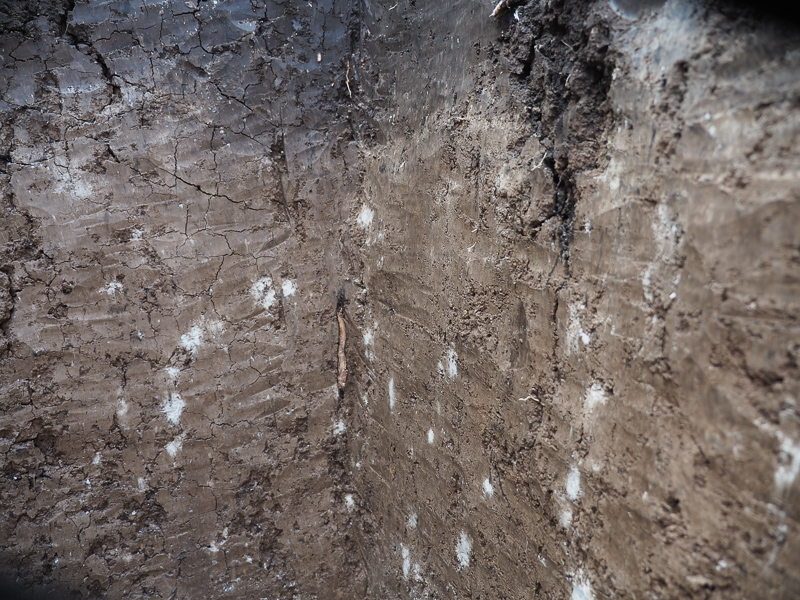
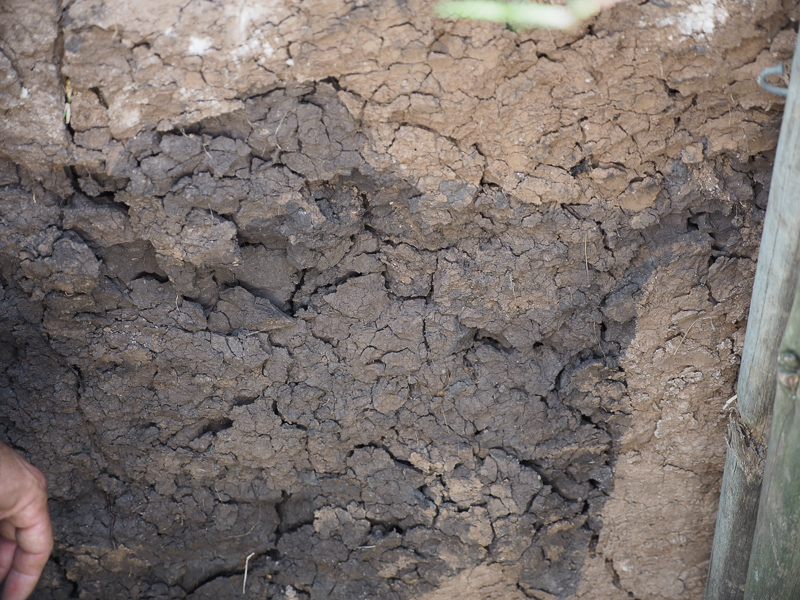
Birds are a problem here, but they have managed to find an innovative solution. Initially, they lost a lot of the harvest to birds: in some parts, the whole crop. They tried using noise, hawks and scarecrows and none of them worked well: they lost quality and quantity. They turned to Argentina for a solution. Argentina has a lot of problems with hail, and on the best vineyards hail nets are used. These can be overhead cathedral-style nets, but they also use nets that wrap the canopy.
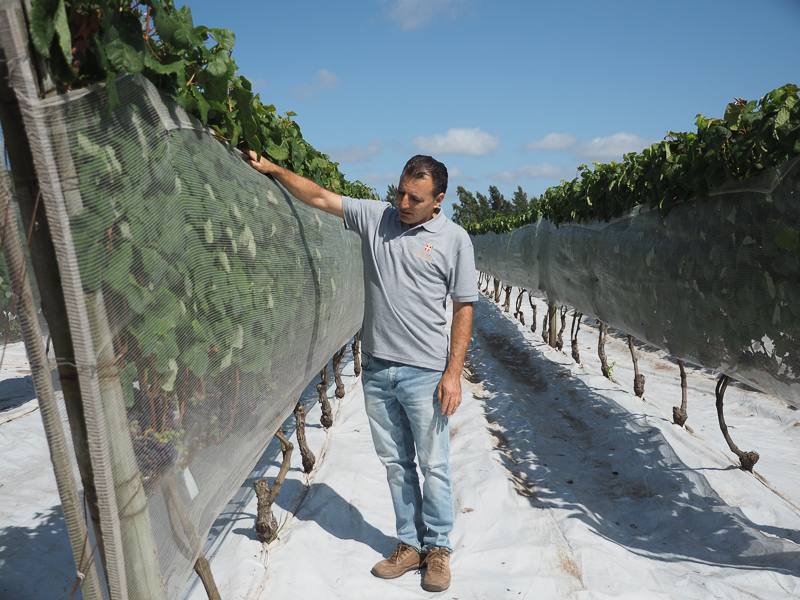
Blumetto and his colleagues adapted these, making them triple purpose. First, they protect against hail. Second, they have found a way to make them protective against birds. And thirdly a side-benefit is that they hold the shoots in the vertical canopy, without the extra work tucking them into the wires. The netting is put on at the beginning of spring. This covers 70 hectares of their vines. They had to do quite a bit of experimentation to get it to work, and also make it so that they could bring it down and raise it again to do any work on the vines. It is expensive, but for the more expensive wines, well worth it.
In the best blocks they do the green harvest (dropping some of the crop so the rest ripens well) on each bunch. Rather than just drop entire bunches, they take the wing and tips off the Tannat in order to have more even ripening. Normally, the tips and wings of each bunch lag behind the main core of the bunch in ripeness. This intervention also has the benefit of opening up the cluster up and reduce disease risk.
They also do vineyard renewal where they cut down trunks, lose a season’s crop, and allow the trunk to redevelop. This is because of trunk disease, and it also allows the vineyard to become more homogeneous and give more even ripening. Every 10-12 years they are doing this on all their vineyards. If they didn’t do this, they’d lose vines to trunk disease which would then be hard to replace. Here, although the trunks never become old vines, they maintain the mature root system of old vines. It’s a trade off, but it works well.
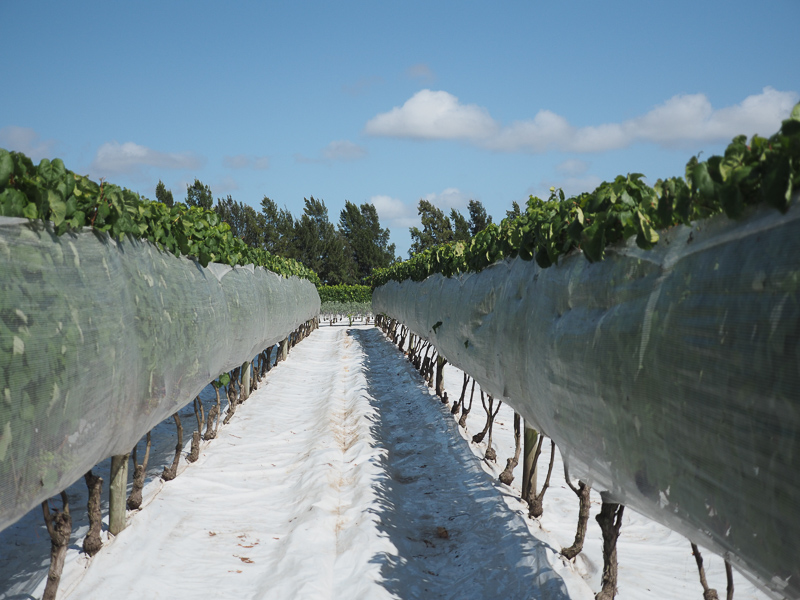
They also use a novel technique to protect from any rainfall close to harvest, using plastic sheeting. This removes the rain from the plot rapidly without allowing it to soak into the ground. They only put the plastic down a month before the harvest. They do this over 7 hectares.
Deicas aren’t organic, but they did have the first certified organic block in Uruguay. They take a sustainable approach, using biological and manual interventions where possible. For example, they use pheromone dispensers for sexual confusion of grape moths. They aim to have as much biodiversity as possible in all the vineyards, and minimize inputs: if they can avoid a treatment they will. They are trying to avoid using herbicides, but haven’t managed yet on 100% of the vineyards.
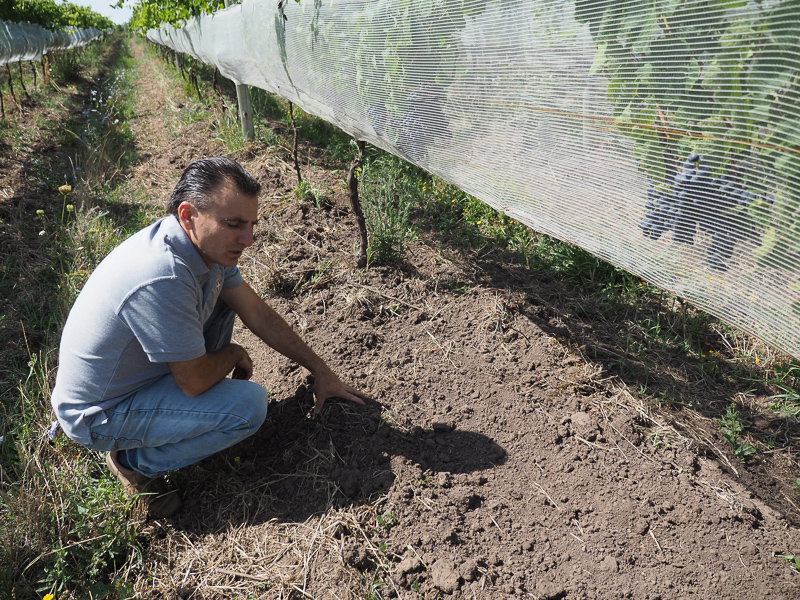
The use a Clemens machine for mechanical weeding. Blumetto says that they have some problems using it in rocky soils. They need to change their mindset and allow a few ‘imperfections’ in the vineyard. ‘Some years ago we were really proud to have everything tidy and clean,’ says Santiago Deicas, ‘but if we want to avoid the use of herbicides it won’t be as perfect.’
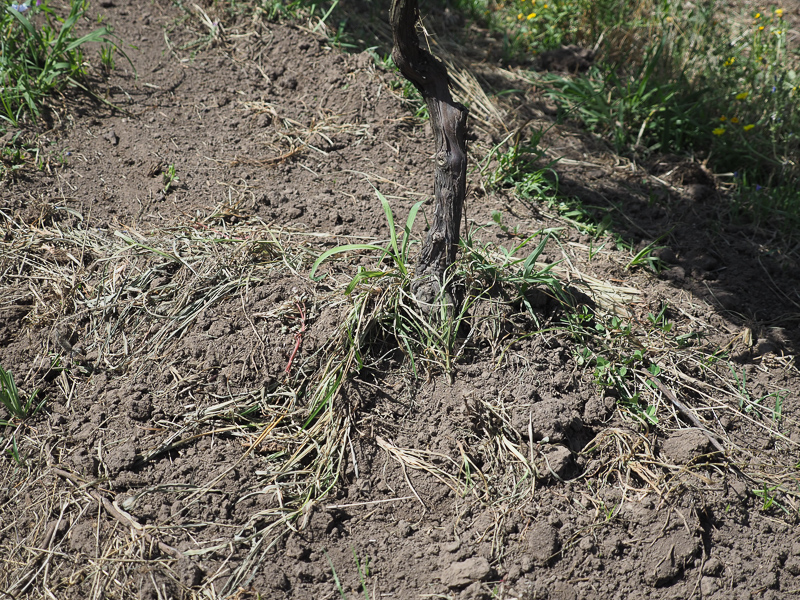
We visited an organically certified vineyard that they own. This has now been organic for 8 years. In one vineyard of Tannat they worked organically for four years but lost two harvests, and cancelled the project. The problems were mildew and ants. Ants are a big problem in Uruguay. They eat the leaves. Gamaret is the variety in the organic vineyard. It’s not totally resistant to mildew, but it is much more resistant than their other varieties. It’s also less susceptible to botrytis. It is a vinifera variety that was obtained by crossing Riechensteiner and Gamay in 1970 in Switzerland. ‘Gamaret is a versatile variety,’ says Santiago Deicas. ‘You can get an early harvest light red or pick later and get a much richer, deeper wine.’
Weed control in this organic block is mechanical. By old school standards the vineyard looks untidy, but now they have learned to tolerate some weed growth. They have planted oats to compete with the more aggressive grasses that would be a problem and just overtake everything else. Having biodiversity helps control any problematic insects: there’s a natural balance.
The lessons they have learned about managing vineyards without herbicide here have helped them with their sustainability on other vineyards. The soil structure here looks lovely. In some of the vineyards where they had been using herbicides for many years, all that was growing in the row was moss.
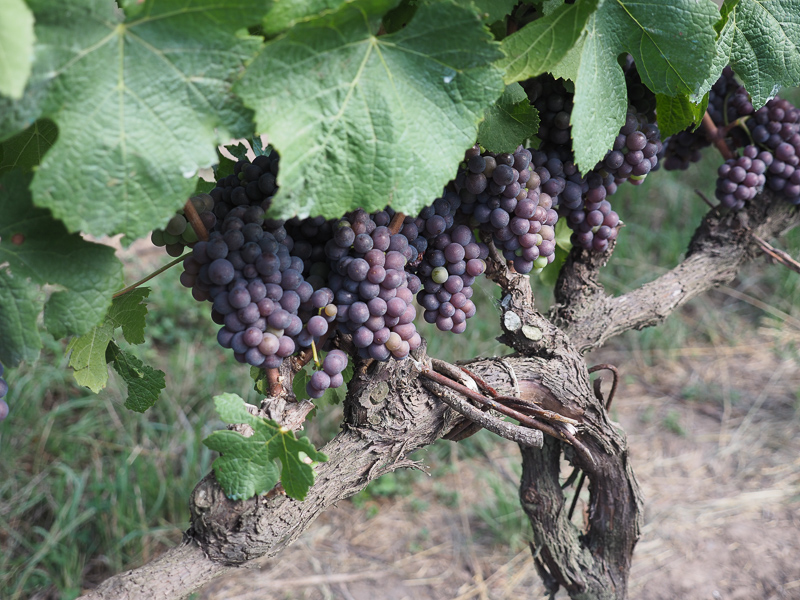
They want to be organic, but in a way that is friendly to the environment, and that is hard in Uruguay because of the weather conditions. ‘We could be organic, but not so friendly to the environment,’ says Santiago. ‘This is something that not many people understand.’ Spraying too much copper and sulfur can be a problem. Sometime using synthetic fungicides can be more environmentally friendly.
They are releasing their first Gamaret in 2020. ‘People worldwide are more interested in tasting things that are not Cabernet Sauvignon,’ says Santiago. ‘This market change might let us grow varieties that are better for the environment.’
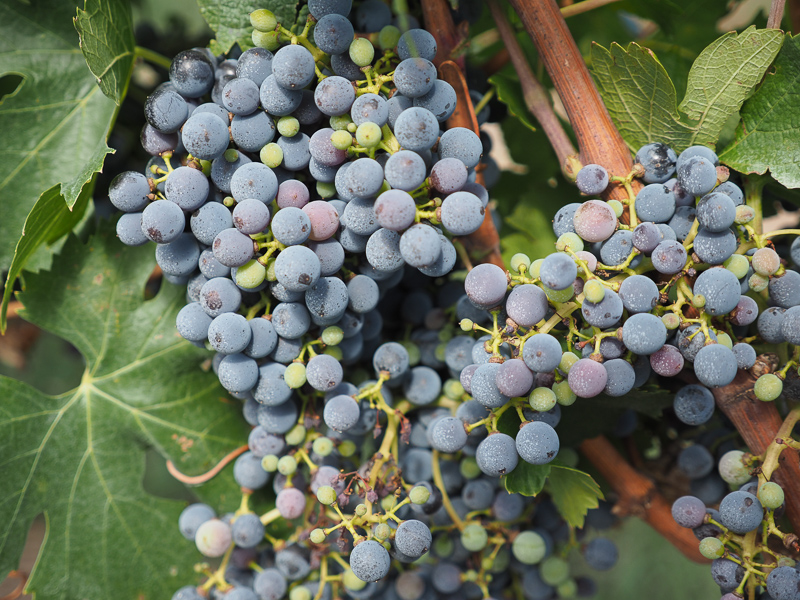
Deicas now use a different winemaking technique for Tannat. They do a super-intense maceration for a short time. This involves lots of punching down for two days, then a bit for three, then they press off with about half the concentration of sugar left and finish off as a white. This avoids extracting from the seeds, and this means they can harvest early without being afraid of bitterness. With a long maceration the seeds would be too green. In the past they concentrated on the ripeness of the seed, but now they look instead at the skins and the flavours.
THE WINES
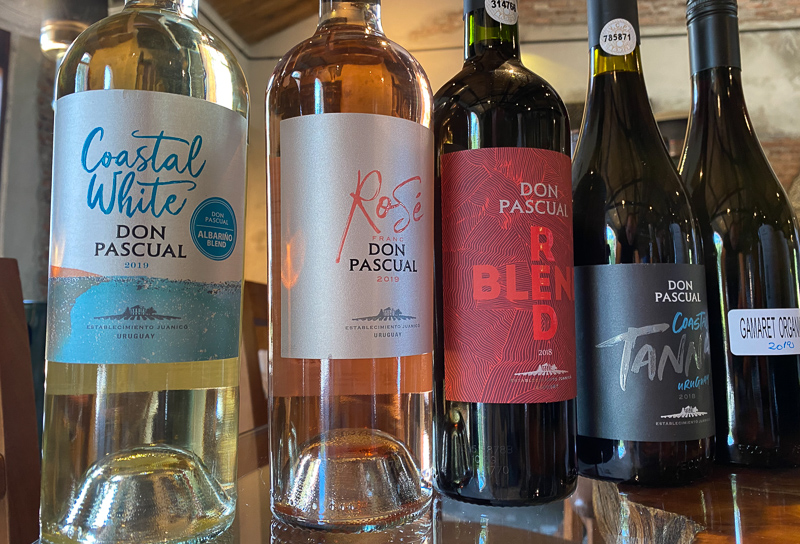
Deicas make a range of different wines. The first is Don Pascual, which is sold in Uruguay and the Americas. This is a big brand.
Don Pascual Coastal White 2019
Albariño-based blend. 4 months in tank. The Chardonnay helps in this blend. Have almost 8 hectares now. This is crisp, juicy, bright and focused with fresh citrus fruit. Light and crisp with lovely freshness. The Albarino dominates the blend. 87/100
‘We think Albariño might become one of the most important varieties for Uruguay,’ says Santiago. ‘We have been tasting in Galicia, where there are a lot of Albariños that are very nice but are dead in a year. We are working with lees contact, and also two harvest times.’
Don Pascual Rosé Franc 2019
Cabernet Franc rosé. Pale pink in colour. This is dry and appealing with nice green leafy notes as well as rounded sweet citrus and cherry fruit. Dry and quite gastronomic, this is bright and attractive. 86/100
Don Pascual Red Blend 2018
They saw a big move to red blends in Canada and the USA, and wanted to make one but without the sugar. ‘We don’t feel comfortable with sugar,’ says Santiago. ‘It has been a huge success in Uruguay. It is easier, and helps bring new consumers to wine.’ This has lovely rounded sweet juicy berry and cherry fruits. Nice soft tannins but still has a bit of structure. A lovely, honest, fruit-driven wine. Based on Cabernet Franc, Merlot and Marselan, but some years has some Tannat in the blend. They work with the mannoproteins in the lees (helping them hydrolyse, keeping them in suspension, keeping only the good lees) to add texture to the wine. Some freshness on the finish. 89/100
Don Pascual Coastal Tannat 2018
This is fresh and fruity with bright cherries and berries. Supple with nice acidity and good tannins. Juicy with a sour cherry edge and nice brightness, and maybe a hint of salinity. Nice notes of dried herbs. 90/100
Don Pascual Gamaret Organico 2018
The organic vineyard is 2 hectares, but only 1.5 can be used for organic because there are some buffer rows. Juicy and berryish with nice bright raspberry and cherry fruit with some herby notes. Very expressive and juicy with a twist of blackcurrant. Nice and crunchy. 89/100
Don Pascual Gamaret Organico 2019
Expressive and quite harmonious with nice brightness to the supple cherry and berry fruits. There’s a fleshiness to this wine with nice texture and a lovely mouthfeel. Elegant and approachable with lovely fruit. 90/100

Bodegones del Sur
These wines take a few more risks. Earlier harvest, some wild yeasts, less sulfur dioxide. This brand goes to Brazil, Europe, Russia and also in Uruguay. The packaging is more artistic, using a Uruguayan artist.
‘Viognier is a tannic variety and needs a different approach in the winery,’ says Santiago, ‘and a different sparkling-like pressing program to avoid the phenolics. If you press too hard the wine starts to oxidise after 6-9 months even though it tasted great earlier.’
Bodegones del Sur Viognier 2019 Juanico
This is rich with nice bold apricot and pear fruit, with some citrus freshness. Nice fruit here with a twist of apple on the finish. Has some personality. 89/100
Bodegones del Sur Cabernet Franc 2019
Unoaked. This is fresh and supple with nice sleek cherry and blackcurrant fruit. It’s fleshy and delicious with lovely fruit intensity and some nice juiciness. There’s a bit of structure. Really fresh and supple and intensely drinkable with subtle green hints. 90/100
Bodegones del Sur Tannat 2019
4-5 days of maceration then finishes fermentation in tank. Very floral and bright on the nose with lovely vibrant berry fruits. The palate is juicy and crunchy with nice freshness and supple green-tinged berry fruits. So drinkable with admirable purity and focus. 91/100
Bodegones del Sur Marselan 2018
This is dark coloured with intense berry and blackcurrant fruit, but there’s also a nice softness to the sweet fruit. Very juicy with lots of colour but low natural tannins with a normal maceration. Easy to see why this grape is so popular here. Has a fresh, vital finish. 90/100
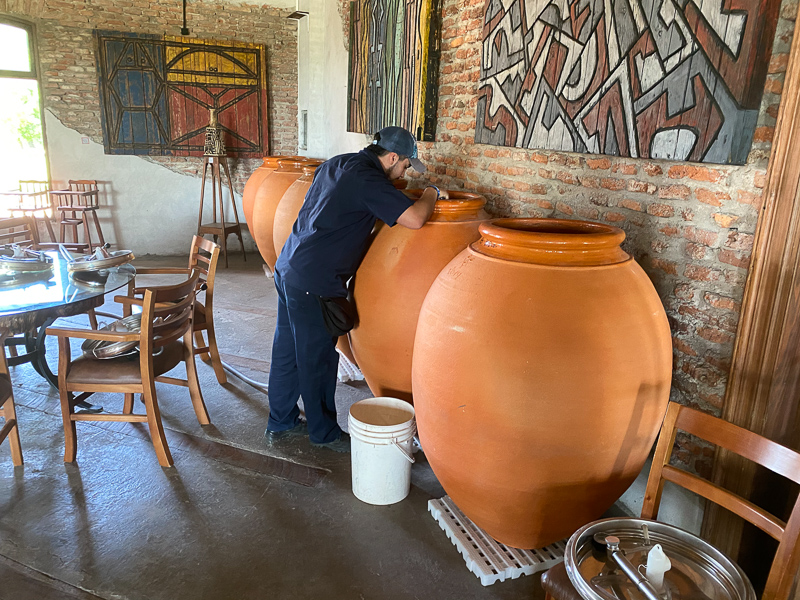
Bizarra
This is a natural wine project. The idea of making an orange wine came with a visit to De Martino in Itata, Chile, where Santiago tasted the Tinajas wines.
He tried experiments with no sulphites. ‘The amount of quality you lose through oxidation is too much,’ he says, so they now use 20 ppm. ‘We are using the techniques of 7000 years ago with the knowledge of today. We know what is happening. For example, avoiding oxygen pick up during wine movements. The cloudiness (lees) in the wine could protect the wine.’
Bizarra Vino Natural Naranja 2019
Petit Manseng and Gros Manseng, co-fermented. These were the healthiest varieties he had in 2019, macerated on skins in open barrels and bins for 35 days, then aged in used barrels and tanks (half and half) for six months. Sulfites used only at bottling. Lovely aromatics of pear, spice and baked apple with some green tea. The palate is lively and bright with good acidity and a juicy edge to the lemony fruit. There’s a bit of grapefruit, too. Some tannic grip on the finish but it works very well with a zesty, lemony finish. Such precision here. 93/100
Bizarra Vino Natural Amphora 2019
Two amphorae, only 900 bottles. This is a tannat. They do the maceration in the bins for 5 days then press to amphora for 3 months. Amphoras come from Spain but they are working on a project to make their own from clay from their vineyard. This is intense and deeply coloured but has a lovely structure and harmony, with a stony edge to the intense black cherry and blackcurrant fruit. There’s an amazing freshness and vitality to this wine. So pure. This is very impressive. 94/100

Familia Deicas
Deicas started working with consultant wine maker Paul Hobbs in 2012. In the whites he thought they were too phenolic and with too many sulphites. He suggested using wild yeasts and no sulphites. They experimented in 2013 with and without sulphites, then put it in barrels. Spontaneous and added yeasts made up the four-way matrix. The wild yeasts started slowly. Finished the fermentation, then waited for malolactic without sulphites. Then, after malolactic there was an addition of sulphites for all wines. The best barrels by far were the wild yeasts with no sulphites. Since 2015 Preludio is completely made in this way. In 2019 they added 30% of sparkling base Chardonnay.
Familia Deicas Preludio Barrel Select Lote No 24 2019 Juanico, Canelones
20% new oak, with 30% sparkling base from tank. This is intense and vivid with concentrated citrus and peach notes. Rich but fresh at the same time with pear and peach fruit and a refined spiciness. Some saline hints. Long and with lots of potential for development. Lots of flavour here. 92/100

Familia Deicas Ocean Blend Rosé 2019
13% alcohol. Very pale in colour. Lively and bright with nice focus to the supple citrus and cranberry fruit. Has a nice texture and a twist of salinity. High acid but it’s well integrated. Dry and gastronomic with lovely purity and focus and a fine hint of green. 92/100
Familia Deicas Atlántico Sur Reserve Pinot Noir 2017
12.5% alcohol. From vertical schist in the south west, and also from the clay/limestone in Progreso. Made with foot treading in bins. Juicy with sweet cherries and plums. Has nice freshness but also a stern, more savoury edge. Some hints of mint and green traces, with compact berry fruits to the fore. 88/100
Familia Deicas Atlántico Sur Reserve Tannat 2018
From south west, south (Progresso) and Garzon. All coastal terroirs. Short intense maceration. Sweetly fruited and rounded with supple berry and cherry fruits. Nicely juicy and bright with good focus to the fruit. Has a slight creamy blackcurrant mid palate, and a fresh crunchy finish. 91/100
Familia Deicas Single Vineyard 2018 Sierra de Mahoma, San José
This is from the south west, where the River Plate is salty and more like a sea than a river. Cabernet Franc co-fermented with a bit of Tannat, and a touch of Cabernet Sauvignon. Vertically fractured schist soils with a lot of iron. This is beautifully poised with fresh cherry and berry fruit. Ripe but very fresh with a savoury bood/iron edge to the fresh fruit, with a lovely purity and focus. This is a serious, well balanced wine. 93/100
They were the first to plant in Garzon in 2006. 17 hectares on decomposed granite with steep slopes.
Familia Deicas Single Vineyard 2018 Garzon, Maldonado
Merlot co-fermented with a bit of Tannat and Marselan, and a small percentage of Petit Verdot. This is really fine: there’s amazing freshness to the supple but concentrated berry fruits. Linear and juicy with great precision, showing fruit brightness but also some luxurious texture. Very fine, with potential for development. 94/100
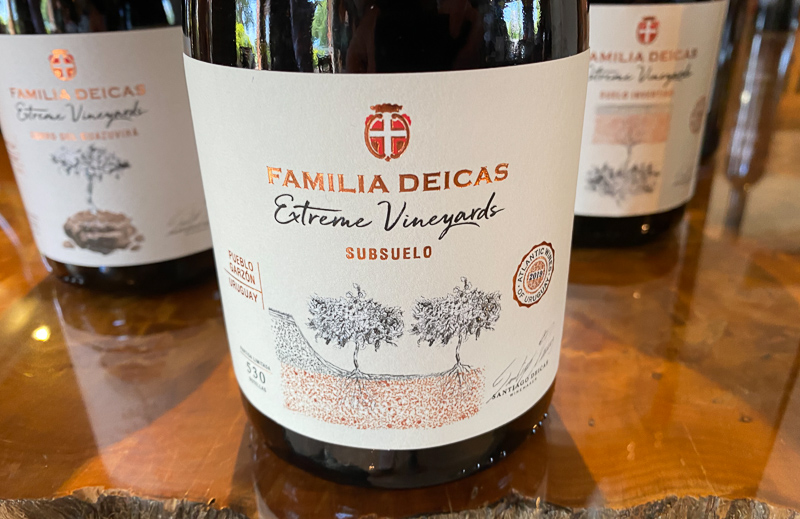
Familia Deicas Extreme Vineyards Subsuelo Pueblo Garzon 2019
12% alcohol. Land was owned by a friend in Garzon, so they went to see the soil here. It had 50 cm fertile top soil and then a rich limestone subsoil. He removed the top soil and then they planted the vineyard. This is the second vintage. The concept is limestone, low temperatures close to the ocean, so they planted Chardonnay and Pinot Noir. This is very fresh and bright with cranberry and red cherry fruit, nice purity, and a lovely acid line. Very fine and pure. When the roots get deeper this could be extraordinary. At the moment it’s fresh and delicious. Just 530 bottles made. This is fabulous, with amazing precision and purity. 94/100

Familia Deicas Extreme Vineyards Cerro del Gazuvira 2018 Lavalleja
Planted over mother rock (granite) on a hill at 300 m, 19 km from the sea. Merlot, Tannat, Petit Verdot and Viognier, cofermented. Dynamite needed to plant. They brought some top soil from the valley for each vine. So intense, fresh and vivid with great concentration of blackberry and blackberry fruit. Has some floral interest, too. Linear, juicy and fresh but also intense with good structure and amazing precision. Some notes of olive and a hint of malted barley, that’s typical of the site. This has a bright future ahead of it. 95/100
Familia Deicas Extreme Vineyards Suelo Invertido Domaine Castelar Tannat 2018
This is fresh, focused and linear with lovely brightness to the raspberry and blackcurrant fruit. It’s very linear and intense with nice precision and good structure. Shows freshness and vitality with good acid line. Grippy and structured with a lovely saline twist on the finish. Lots of layers of flavour here. A bit firm now, but has promise for the future. Santiago says you get grapefruit and mango here every year. 94/100
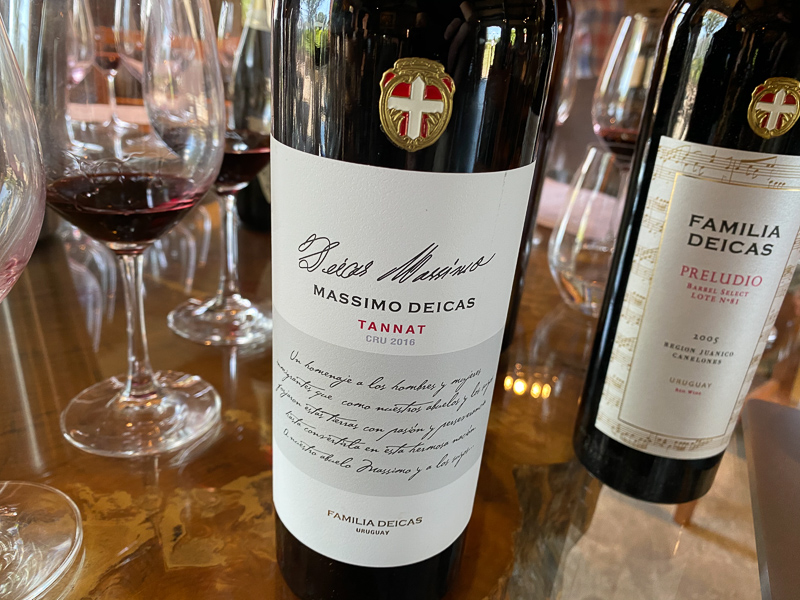
Familia Deicas Massimo Deicas Tannat 2016
Nine months in 50% new oak. This has gone through some changes in style: it used to be super-concentrated in 100% new oak, but now they are shifting to a fresher less oaky style. This is a blend of three regions: Mauma, Progresso and Garzon. It’s concentrated and dense with some sweet blackcurrant and blackberry fruit with some structure and also some oak in the background. This is so expressive with lovely focus and depth. It’s ripe but also well balanced, and has elements of both the old and new worlds. Serious stuff. 94/100
Familia Deicas Preludio Barrel Select Lote 102 2015 Juanico, Canelones
A blend of Tannat, Merlot, Cabernet Franc, Cabernet Sauvignon, Petit Verdot and Marselan. Good concentration here with some firm tannins under the blackcurrant and cherry fruit with freshness and some gravelly depth. There are some floral notes here, but the core is savoury, gravelly and quite stern, with good tannins. Has richness but also a lot of structure. Satisfying stuff. 93/100
Familia Deicas Preludio Barrel Select Lote No 81 2005
Some development on the nose with tarry, ashy, cedary notes as well as a touch of malt. The palate has nice complexity with sweet blackcurrant and berry fruit as well as olives and herbs, as well as a saltiness and some meaty depth. Really attractive with nice complex, warm, broad flavours. 92/100

Familia Deicas Preludio Barrel Select Lote No 50 1999
This has developed really well with focused black fruits supported by some tar and leather, as well as a hint of earth. Nice brightness with some integrated green notes, and nice weight. Still has a lot of fruit and structure, and could probably carry on developing for a while. Some iodine on the finish. 94/100
URUGUAY SERIES
Find these wines with wine-searcher.com

